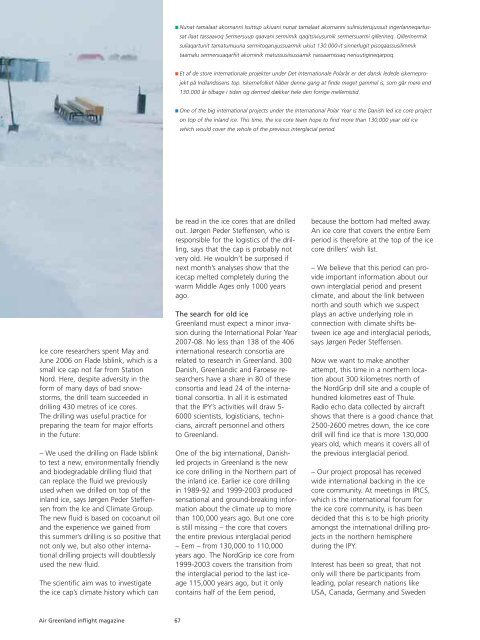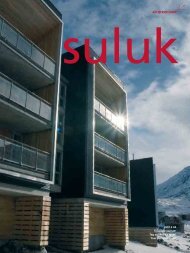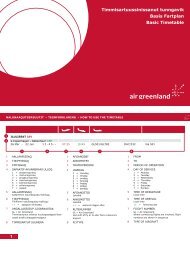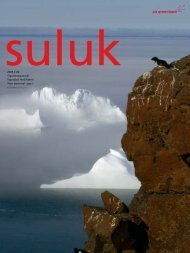2007 # 01 Tigoriannguaruk! Tag suluk med hjem! Your personal copy!
2007 # 01 Tigoriannguaruk! Tag suluk med hjem! Your personal copy!
2007 # 01 Tigoriannguaruk! Tag suluk med hjem! Your personal copy!
Create successful ePaper yourself
Turn your PDF publications into a flip-book with our unique Google optimized e-Paper software.
Ice core researchers spent May and<br />
June 2006 on Flade Isblink, which is a<br />
small ice cap not far from Station<br />
Nord. Here, despite adversity in the<br />
form of many days of bad snowstorms,<br />
the drill team succeeded in<br />
drilling 430 metres of ice cores.<br />
The drilling was useful practice for<br />
preparing the team for major efforts<br />
in the future:<br />
– We used the drilling on Flade Isblink<br />
to test a new, environmentally friendly<br />
and biodegradable drilling fluid that<br />
can replace the fluid we previously<br />
used when we drilled on top of the<br />
inland ice, says Jørgen Peder Steffensen<br />
from the Ice and Climate Group.<br />
The new fluid is based on cocoanut oil<br />
and the experience we gained from<br />
this summer’s drilling is so positive that<br />
not only we, but also other international<br />
drilling projects will doubtlessly<br />
used the new fluid.<br />
The scientific aim was to investigate<br />
the ice cap’s climate history which can<br />
Air Greenland inflight magazine 67<br />
■ Nunat tamalaat akornanni Issittup ukiuani nunat tamalaat akornanni suliniuterujussuit ingerlanneqartussat<br />
ilaat tassaavoq Sermersuup qaavani sermimik qaqitsiviusumik sermersuarmi qillerineq. Qillerinermik<br />
suliaqartunit tamatumuuna sermitoqarujussuarmik ukiut 130.000-it sinnerlugit pisoqaassusilimmik<br />
taamalu sermersuaqarfiit akorninik matussusiisussamik nassaarnissaq neriuutigineqarpoq.<br />
■ Et af de store internationale projekter under Det Internationale Polarår er det dansk ledede iskerneprojekt<br />
på Indlandsisens top. Iskernefolket håber denne gang at finde meget gammel is, som går mere end<br />
130.000 år tilbage i tiden og der<strong>med</strong> dækker hele den forrige mellemistid.<br />
■ One of the big international projects under the International Polar Year is the Danish led ice core project<br />
on top of the inland ice. This time, the ice core team hope to find more than 130,000 year old ice<br />
which would cover the whole of the previous interglacial period.<br />
be read in the ice cores that are drilled<br />
out. Jørgen Peder Steffensen, who is<br />
responsible for the logistics of the drilling,<br />
says that the cap is probably not<br />
very old. He wouldn’t be surprised if<br />
next month’s analyses show that the<br />
icecap melted completely during the<br />
warm Middle Ages only 1000 years<br />
ago.<br />
The search for old ice<br />
Greenland must expect a minor invasion<br />
during the International Polar Year<br />
<strong>2007</strong>-08. No less than 138 of the 406<br />
international research consortia are<br />
related to research in Greenland. 300<br />
Danish, Greenlandic and Faroese researchers<br />
have a share in 80 of these<br />
consortia and lead 24 of the international<br />
consortia. In all it is estimated<br />
that the IPY’s activities will draw 5-<br />
6000 scientists, logisticians, technicians,<br />
aircraft personnel and others<br />
to Greenland.<br />
One of the big international, Danishled<br />
projects in Greenland is the new<br />
ice core drilling in the Northern part of<br />
the inland ice. Earlier ice core drilling<br />
in 1989-92 and 1999-2003 produced<br />
sensational and ground-breaking information<br />
about the climate up to more<br />
than 100,000 years ago. But one core<br />
is still missing – the core that covers<br />
the entire previous interglacial period<br />
– Eem – from 130,000 to 110,000<br />
years ago. The NordGrip ice core from<br />
1999-2003 covers the transition from<br />
the interglacial period to the last iceage<br />
115,000 years ago, but it only<br />
contains half of the Eem period,<br />
because the bottom had melted away.<br />
An ice core that covers the entire Eem<br />
period is therefore at the top of the ice<br />
core drillers’ wish list.<br />
– We believe that this period can provide<br />
important information about our<br />
own interglacial period and present<br />
climate, and about the link between<br />
north and south which we suspect<br />
plays an active underlying role in<br />
connection with climate shifts between<br />
ice age and interglacial periods,<br />
says Jørgen Peder Steffensen.<br />
Now we want to make another<br />
attempt, this time in a northern location<br />
about 300 kilometres north of<br />
the NordGrip drill site and a couple of<br />
hundred kilometres east of Thule.<br />
Radio echo data collected by aircraft<br />
shows that there is a good chance that<br />
2500-2600 metres down, the ice core<br />
drill will find ice that is more 130,000<br />
years old, which means it covers all of<br />
the previous interglacial period.<br />
– Our project proposal has received<br />
wide international backing in the ice<br />
core community. At meetings in IPICS,<br />
which is the international forum for<br />
the ice core community, is has been<br />
decided that this is to be high priority<br />
amongst the international drilling projects<br />
in the northern hemisphere<br />
during the IPY.<br />
Interest has been so great, that not<br />
only will there be participants from<br />
leading, polar research nations like<br />
USA, Canada, Germany and Sweden











